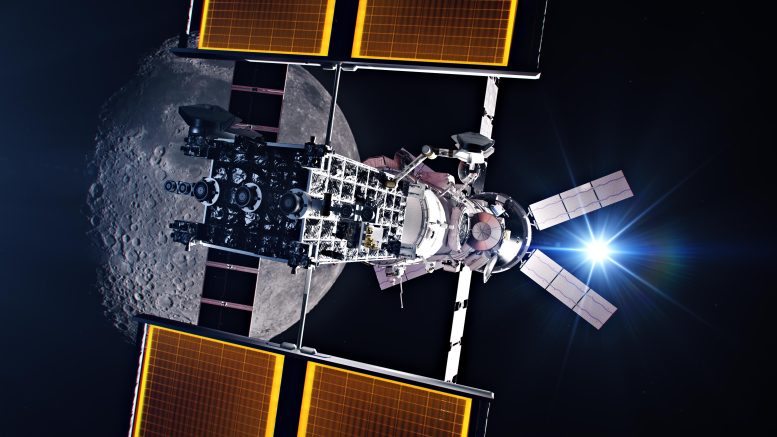NASA’s Gateway Unveiled: A Stunning Tour of Humanity’s First Space Station to Orbit the Moon

The Gateway space station hosts the Orion spacecraft and SpaceX’s deep space logistics spacecraft in a polar orbit around the Moon, supporting scientific discovery on the lunar surface during the Artemis IV mission. Credit: NASA / Alberto Bertolin
<span class="glossaryLink" aria-describedby="tt" data-cmtooltip="
” data-gt-translate-attributes=”[{"attribute":"data-cmtooltip", "format":"html"}]” tabindex=”0″ role=”link”>NASA and its partners are launching Gateway, a lunar-orbiting space station, by 2028.
This station will serve as a hub for deep space exploration, featuring advanced modules for power, habitation, and science. It will support the Artemis missions with its sophisticated systems, including the Power and Propulsion Element, HALO, and contributions from international agencies like ESA and <span class="glossaryLink" aria-describedby="tt" data-cmtooltip="
” data-gt-translate-attributes=”[{"attribute":"data-cmtooltip", "format":"html"}]” tabindex=”0″ role=”link”>JAXA.
Witness Gateway in stunning detail with this video that brings the future of lunar exploration to life:
[embedded content]
NASA, in collaboration with international partners, will explore the scientific mysteries of deep space with Gateway, humanity’s first space station to orbit the Moon. Starting with the Artemis IV mission in 2028, the international teams of astronauts living, conducting science, and preparing for missions to the lunar South Pole region on Gateway will be the first humans to make their home in deep space.
This artist’s computer-generated animation presents an exterior tour of Gateway in stunning detail. Depicted Gateway elements are the:
- Power and Propulsion Element that will make Gateway the most powerful solar electric spacecraft ever flown. The module will use the Sun’s energy to power the space station’s subsystems and ionize xenon gas to produce the thrust that will maintain Gateway’s unique polar orbit around the Moon.
- HALO (Habitation and Logistics Outpost), Gateway’s command and control nexus provides communications between Earth and the lunar surface with the Lunar Link system provided by ESA (<span class="glossaryLink" aria-describedby="tt" data-cmtooltip="
European Space AgencyThe European Space Agency (ESA) is an intergovernmental organization dedicated to the exploration of space, established in 1975. Composed of 22 member states, ESA conducts a broad range of missions focused on Earth observation, human spaceflight, scientific exploration of the solar system, and the development of related technologies and infrastructure. It collaborates extensively with other space agencies around the world, such as NASA, to undertake significant joint missions, including the International Space Station (ISS) and the Hubble Space Telescope. ESA also plays a crucial role in developing satellite-based technologies and services that benefit Europe and the world, including telecommunications, navigation, and environmental monitoring.
” data-gt-translate-attributes=”[{"attribute":"data-cmtooltip", "format":"html"}]” tabindex=”0″ role=”link”>European Space Agency). HALO will house life support systems, including exercise equipment, and science payload banks.
- Lunar I-Hab, provided by ESA with hardware contributions from JAXA (Japan Aerospace Exploration Agency), will host environmental control and life support systems, sleeping quarters, and a galley, among other features.
- Lunar View, provided by ESA, will have refueling capabilities for the Power and Propulsion Element, cargo storage, and large windows.
- Crew and Science Airlock, provided by the Mohammad Bin Rashid Space Centre of the United Arab Emirates, for crew and hardware transfer from Gateway’s interior to the vacuum of space.
- Canadarm3 advanced external robotic system provided by CSA (Canadian Space Agency).
- Deep Space Logistics spacecraft that will transport cargo to Gateway to support Artemis missions.
- Initial Gateway science payloads will study solar and cosmic radiation, a little-understood phenomenon that is a chief concern for people and hardware traveling through deep space, including <span class="glossaryLink" aria-describedby="tt" data-cmtooltip="
MarsMars is the second smallest planet in our solar system and the fourth planet from the sun. It is a dusty, cold, desert world with a very thin atmosphere. Iron oxide is prevalent in Mars' surface resulting in its reddish color and its nickname "The Red Planet." Mars' name comes from the Roman god of war.
” data-gt-translate-attributes=”[{"attribute":"data-cmtooltip", "format":"html"}]” tabindex=”0″ role=”link”>Mars. The payloads visible in this video are ERSA (European Radiation Sensors Array), provided by ESA, attached to the Power and Propulsion Element, and the NASA-led HERMES (Heliophysics Environmental and Radiation Measurement Experiment Suite) is attached to HALO. A third radiation science payload, IDA (Internal Dosimeter Array), provided by ESA and JAXA, will be inside of HALO.
This video also depicts:
- The Orion spacecraft docked to the Crew and Science Airlock. Orion will transport international teams of astronauts and three modules (Lunar I-Hab, Lunar View and the Crew and Science Airlock) to the Gateway space station.
- Government-reference Human Landing System (HLS) that will ferry astronauts to and from the lunar South Pole region. <span class="glossaryLink" aria-describedby="tt" data-cmtooltip="
SpaceXCommonly known as SpaceX, Space Exploration Technologies Corp. is a private American aerospace manufacturer and space transport services company that was founded by Elon Musk in 2002. Headquartered in Hawthorne, California, the company designs, manufactures, and launches advanced rockets and spacecraft. SpaceX's ultimate goal is to reduce space transportation costs and enable the colonization of Mars.
” data-gt-translate-attributes=”[{"attribute":"data-cmtooltip", "format":"html"}]” tabindex=”0″ role=”link”>SpaceX and Blue Origin are on contract to provide the Starship HLS and Blue Moon HLS, respectively.
Gateway is part of the Artemis architecture to return humans to the lunar surface for scientific discovery and chart a path for human exploration further into the solar system, such as to Mars and beyond.
